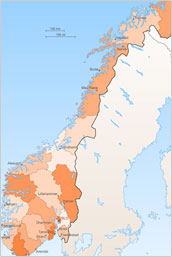What is Norwegian Rosemaling?
The folk art, rosemaling – or flower painting – was popular in agrarian southern Norway during the 1700’s to the late 1800’s. Inspired by painted church interiors and influenced by the Baroque and Rococo styles, local self-taught farmers decorated farmhouse interiors and functional items such as trunks, bowls, and cabinets.
The art displays many stylized flowers and scroll forms, combining blended colors and fine outlines on a plain background color. Traditional paint colors were derived from local raw materials, for example, rust red came from red iron oxide in the ground. Brushes were made of hairs from a squirrel’s tail or a cow’s ear.
Rosmaling artists often worked as farmers during the summer, subsidizing their living in the winter months painting rooms and furniture for more successful farmers, receiving little more than room and board for their compensation.
Originally, each isolated mountain valley developed unique stylistic traditions. The northern coastal areas of Norway being dependent on fishing did not have the time to develop a decorative art tradition. The Industrial Revolution made this art obsolete.
How did Rosemaling come to America?
Per Lysne, a Norwegian immigrant from Stoughton, Wisconsin rekindled an interest in Scandinavian folk art when his “Smørgaasbord” plates were sold in Chicago’s Marshall Fields department store in the late 1930’s. European folk art was rediscovered through home decorating magazine articles in the 1930’s and 1940’s.
The Vesterheim, Norwegian American Museum in Decorah, IA sponsored the first national rosemaling competition in 1967, bringing extensive awareness of the art’s direction and popularity. The competition continues to attract talented and progressive artists who nurture this obscure ethnic art. It has transcended time, and continents again to the extent that today, artists in Korea and Japan have adopted the styles and techniques.
Vesterheim is the largest ethnic museum in the United States. It has become the foremost source for rosemaling research with its vast collection of painted immigrant artifacts together with examples of other decorative arts from Norway such as carving, textiles, silver, et. al. It fosters the continuance of Norwegian traditional arts with ongoing classes in many disciplines, offers special interest tours to Norway and maintains a comprehensive book store and a supply store for folk artists.
Well-known regional styles include:
 Gudbrandsdal: Painters competed with the expert acanthus carvers of this valley and developed a unique dimensional depth with scrolls and turning leaves.
Gudbrandsdal: Painters competed with the expert acanthus carvers of this valley and developed a unique dimensional depth with scrolls and turning leaves.
 Hallingdal: The essence of traditional rosemaling with its symmetry and limited palette.
Hallingdal: The essence of traditional rosemaling with its symmetry and limited palette.
 Os: The west coast style favors large flowers with fern like leaves.
Os: The west coast style favors large flowers with fern like leaves.
 Telemark: Asymmetrical with scrolls, flowers and exuberant flourish lines.
Telemark: Asymmetrical with scrolls, flowers and exuberant flourish lines.
Vest – Agder: Influenced by constant trade with Holland, this style changed rapidly, includes urns with tulips and saw toothed leaves.
What is Swedish Folk Art ?
Sweden’s folk art in the 18th and 19th centuries has two regional distinctions. The southern area of Halland and Småland with its farming society, and the central part known as Dalarna rich in timber and copper mines.
A common element to all Swedish folk art is the inclusion of at least one flowering plant often identified as a kurbit (gourd) that pays homage to the bible’s Book of Jonah (4:6). Jonah’s plight in the desert is relieved when God causes a large gourd plant to grow and shade him from the sun. The kurbit symbolizes protection.
Cabinets, boxes and sleds were often painted as in Norway, using different motifs and background techniques. The unique element of Sweden’s folk art was a temporary, or permanent wall decoration inspired by the woven biblical tapestries decorating local churches. The subject matter in both regions changed from bible stories to scenes with royalty, hunting, wedding and seasonal landscapes as 19th century beliefs began to realize the importance of the common man and everyday life.
Bonadsmålning – Southern Swedish Folk Art
Why were these “tapestries” so important? It was the duty of church members to know bible stories, but few parishioners were literate. Church pastors conducted tests of bible knowledge to congregants and these wall hangings enabled one to confidently recount religious events. Farmers would commission itinerant artists to paint their favorite biblical narratives on long linen runners (later made of paper) to hang along their long cottage walls during seasonal festivities. They could be rolled up and stored away from the constant presence of soot produced from the cooking hearth. Favorite stories included the Three Kings, the Wise and Foolish Virgins, St. George and the Dragon and the Wedding at Cana.
Dalmålning – Central Sweden’s Folk Art
There was comparably more wealth in central Sweden and architecture more suited to the merchant class selling timber and copper from this region. Manor houses devoted a spacious room solely to entertain friends and visiting guests. The owners could afford to hire artists who were formally trained, or very proficient locals to decorate these “party rooms”. The caliber of painting was more sophisticated than in the south, and the advent of paper production made it more convenient to fix large paintings permanently to wall spaces. Designs with elaborate draperies and tassels, formal urns overflowing with flowers and columns complement figures in the paintings.
Swedish Folk Art Terms



Bondesmålning: Farmer or peasant painting
Blomstermålning: Flower painting
Kurbit painting: Gourd painting. The telescoping flowering plant present in most Swedish folk art pays homage to the Book of Jonah (4:6) in the bible.


